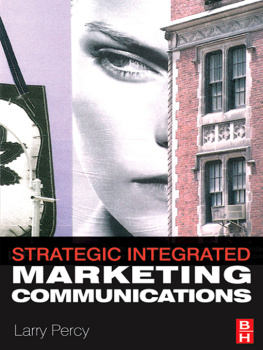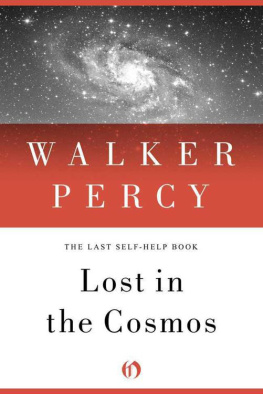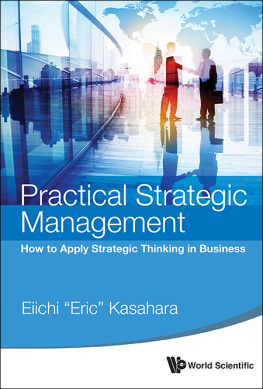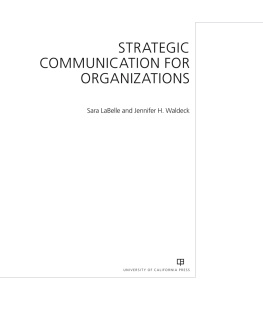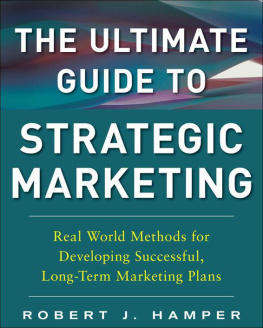Percy - Strategic Integrated Marketing Communication: Theory and Practice
Here you can read online Percy - Strategic Integrated Marketing Communication: Theory and Practice full text of the book (entire story) in english for free. Download pdf and epub, get meaning, cover and reviews about this ebook. City: Oxford, year: 2008, publisher: Taylor & Francis;Butterworth-Heinemann, genre: Business. Description of the work, (preface) as well as reviews are available. Best literature library LitArk.com created for fans of good reading and offers a wide selection of genres:
Romance novel
Science fiction
Adventure
Detective
Science
History
Home and family
Prose
Art
Politics
Computer
Non-fiction
Religion
Business
Children
Humor
Choose a favorite category and find really read worthwhile books. Enjoy immersion in the world of imagination, feel the emotions of the characters or learn something new for yourself, make an fascinating discovery.
Strategic Integrated Marketing Communication: Theory and Practice: summary, description and annotation
We offer to read an annotation, description, summary or preface (depends on what the author of the book "Strategic Integrated Marketing Communication: Theory and Practice" wrote himself). If you haven't found the necessary information about the book — write in the comments, we will try to find it.
Percy: author's other books
Who wrote Strategic Integrated Marketing Communication: Theory and Practice? Find out the surname, the name of the author of the book and a list of all author's works by series.
Strategic Integrated Marketing Communication: Theory and Practice — read online for free the complete book (whole text) full work
Below is the text of the book, divided by pages. System saving the place of the last page read, allows you to conveniently read the book "Strategic Integrated Marketing Communication: Theory and Practice" online for free, without having to search again every time where you left off. Put a bookmark, and you can go to the page where you finished reading at any time.
Font size:
Interval:
Bookmark:

In the world of marketing, there is no question that certain areas that have been practiced in one way or another over the years are suddenly dressed up in new clothes and touted as the new thing. Relationship marketing comes quickly to mind. Marketers always understood (or certainly should have) the importance of sound relationships with their customers, but the mid-1990s saw an inundation of articles in the business press, airport books, and even academic work, in the area of relationship marketing. Today, it seems to have morphed into customer relationship marketing, or CRM, and as we shall later see this idea is even informing definitions of IMC.
Why do we bring this up at the beginning of a book on integrated marketing communication? It is to make the point that unlike many fads in marketing, the idea of IMC really was something new in marketing; at least IMC correctly implemented. In fact, in the twenty or so years since the emergence of the idea of IMC in the mid- to late 1980s, few companies have yet been able to truly implement effective IMC. We shall touch on several of the key reasons why later in this chapter. First, however, we need to understand just what is meant by integrated marketing communication or IMC.
We might briefly define IMC as the planning and execution of all types of advertising-like and promotion-like messages selected for a brand, service, or company, in order to meet a common set of communication objectives, or more particularly, to support a single positioning. We believe strongly that the key to IMC is planning , and the ability is to deliver a consistent message.
In 1989, the American Association of Advertising Agencies (known as the Four As) formed a task force on integration that was to define IMC from the viewpoint of the Four As agencies. The task force came up with this definition of IMC: A concept of marketing communications planning that recognizes the added value of a comprehensive plan that evaluates the strategic roles of a variety of communication disciplines (e.g. general advertising, direct response, sales promotion, and public relations) and combines these disciplines to provide clarity, consistency, and maximum communication impact.
In the same year, the investment firm Shearson-Lehman Hutton (1989) issued a detailed report on consumer advertising, with special emphasis on diversification into areas that would lead to integration. They concluded that a number of changes at work in the marketplace would force traditional packaged goods marketers to take a much more integrated approach to marketing. They noted that high-involvement non-service products (e.g. automobiles or cruise vacations) where the selling task is more complicated were at that time more apt to use integrated strategies. In general, the report concluded that the dynamics were in place for a surge in demand for integrated communications from all kinds of advertisers.
In their 1993 book Integrated Marketing Communication (perhaps the first book to really deal with the subject), Don Schultz and his colleagues talked about IMCs as a new way of looking at the whole where once we only saw parts such as advertising, public relations, sales promotions, purchasing, employee communications and so forth (Schultz et al., 1993). They saw IMC as realigning communications to look at it in the way the consumer sees it, as a flow of information from indistinguishable sources. They observed that professional communicators have always been condescendingly amused that consumers call everything advertising or public relations. Now they recognize with concern, if not chagrin, that that is exactly the point. It is all one thing to the consumer who sees or hears it. They go on to say that IMC means talking to people who buy or dont buy based on what they see, hear, feel, and so on, and not just about a product or service. It also means delivering a return on investment, not just spending a budget. This definition looks back at the goals of IMC. We will be looking at IMC largely from a strategic perspective for planning and implementing IMC.
At Northwestern Universitys Medill School in the USA (where Schultz was teaching) the curriculum was in fact changed to focus on this new idea of IMC rather than the more traditional programs in advertising. At the time, they offered their own working definition (Schultz, 1993): Integrated marketing communications is the process of developing and implementing various forms of persuasive communication programs with customers and prospects over time. The goal of IMC is to influence or directly affect the behaviour of the selected communications audience. IMC considers all sources of brand or company contacts that a customer or prospect has with the product or service as potential delivery channels for future messages. Further, IMC makes use of all forms of communication which are relevant to the customers and prospects, and to which they might be receptive. In sum the IMC process starts with the customer or prospect and then works back to determine and define the forms and methods through which persuasive communications programs should be developed.
This definition, while more elaborate than ours, is still basically addressing the need for overall communication planning. It is critical to consider IMC as a process , not a thing.
The 1989 Four As definition was utilized in a study of large consumer packaged goods advertisers in 1991. The study was conducted among senior marketing executives of major packaged goods advertisers. Based upon the Four As definition, two-thirds of the companies interviewed said that they were in fact now integrated. Generally the managers of these companies believed that IMC is a sound idea and that it has real value to their organizations. Most also believed that IMCs programs would increase the overall effect and impact of their marketing communications programs (Caywood et al., 1991).
Many of the questions in the study dealt with the reliance on or participation of advertising agencies in this integration process. While many of the managers believed that they would rely more heavily on outside marketing communications people in the future and that placing their business with one agency would make them a more important client, they were split on whether or not they would actually use the broader range of services which they expected advertising agencies to be offering. Part of this apparent inconsistency might be explained by the relatively strong disagreement these managers had with the proposition that most of the new ideas in marketing communications actually come from advertising agencies.
In fact, the study generally found that advertising agencies would probably not be a favorite supplier of IMCs. Many of the advantages that were seen by advertising agencies as reasons for them to be the integrating force for communications programs apparently were either not important to client companies or else they were not believed. Managers of these companies tended to feel that agencies that offered a variety of different communications alternatives beyond their traditional role would not necessarily have the highest level of talent across all areas of need. This study seems to indicate that advertisers in the early years of IMC were not convinced that advertising agencies were the best qualified to coordinate an IMC program, or that they could do it more cost effectively. Apparently advertising agencies had not demonstrated in the IMC programs they had been coordinating that using a single agency is the best way to implement an IMC program.
Font size:
Interval:
Bookmark:
Similar books «Strategic Integrated Marketing Communication: Theory and Practice»
Look at similar books to Strategic Integrated Marketing Communication: Theory and Practice. We have selected literature similar in name and meaning in the hope of providing readers with more options to find new, interesting, not yet read works.
Discussion, reviews of the book Strategic Integrated Marketing Communication: Theory and Practice and just readers' own opinions. Leave your comments, write what you think about the work, its meaning or the main characters. Specify what exactly you liked and what you didn't like, and why you think so.

